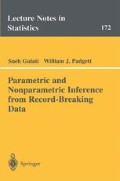Abstract
Everyone is interested in records, weather records, sports records, crime statistics, and so on. Record values are kept for almost every conceivable phenomenon. What was the coldest day last year (or ever), which city has the lowest crime rate, what was the shortest time recorded to complete a marathon, who holds the record in eating the most number of hot dogs in the shortest period, what was the highest stock value thus far? The list could go on and on; there is even a book that lists all kinds of records broken during a given year—the well-known Guinness Book of World Records! Naturally, if there is a subject concerning statistical values that interests the majority of people in the world, it has to be of interest to statisticians. However, how does one relate record values to statistical theory? The easiest way to explain this is with some examples. To begin with, consider a sports event: Not only do we want to know who holds the record for running 100 meters in the Olympics, but we also want to predict the next record-breaking time. Similarly, we want to determine if Miami, Florida, will still have the highest auto theft rate next year, or will Los Angeles still be the most polluted city in the US next year. Or we would like to predict the next highest closing price of a particular stock. In all of these examples, we want to use past data to predict the future. And prediction of the future using past data requires statistical theory.
Access this chapter
Tax calculation will be finalised at checkout
Purchases are for personal use only
Preview
Unable to display preview. Download preview PDF.
Author information
Authors and Affiliations
Rights and permissions
Copyright information
© 2003 Springer Science+Business Media New York
About this chapter
Cite this chapter
Gulati, S., Padgett, W.J. (2003). Introduction. In: Parametric and Nonparametric Inference from Record-Breaking Data. Lecture Notes in Statistics, vol 172. Springer, New York, NY. https://doi.org/10.1007/978-0-387-21549-5_1
Download citation
DOI: https://doi.org/10.1007/978-0-387-21549-5_1
Publisher Name: Springer, New York, NY
Print ISBN: 978-0-387-00138-8
Online ISBN: 978-0-387-21549-5
eBook Packages: Springer Book Archive

